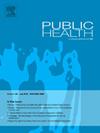A network approach to understanding psychosocial and economic factors in suicidal ideation among young adults
IF 3.2
3区 医学
Q1 PUBLIC, ENVIRONMENTAL & OCCUPATIONAL HEALTH
引用次数: 0
Abstract
Objectives
Suicidal ideation results from complex interconnections among psychosocial and economic factors. We aimed to identify factors associated with suicidal ideation and explore the patterns of their interactions within a network structure.
Study design
Cross-sectional study.
Methods
We analyzed data from the 2022 Seoul Young Adult Panel Study, a representative sample of 4996 young adults in Seoul, South Korea. Suicidal ideation was assessed alongside demographic, economic, and psychological factors. Logistic regression analysis was conducted to identify psychosocial and economic factors associated with suicidal ideation. Subsequently, a network analysis was used to explore the structural relationships among these factors.
Results
The prevalence of suicidal ideation among young adults was 14.5 %. Logistic regression analysis showed some psychosocial (i.e., future orientation, happiness, social withdrawal, depression symptoms, and loneliness) and economic (i.e., debt, financial hardship, and objective and subjective income) factors were associated with suicidal ideation. Network analysis showed that depression symptoms and loneliness, as core factors within the network, had stronger connections to suicidal ideation compared to other factors. Other psychosocial (e.g., social withdrawal) and economic (e.g., financial hardship) factors were less directly associated with suicidal ideation but indirectly associated with it through the mediation of depression symptoms and loneliness.
Conclusions
Our analysis showed connections between psychosocial and economic factors and suicidal thoughts. Depression and loneliness were central, but other psychosocial and economic factors also played an important role through their connections to these key factors. A comprehensive and collaborative public health approach is important for reducing suicide risk across the population.
了解年轻人自杀意念的社会心理和经济因素的网络方法
目的自杀意念是社会心理和经济因素相互作用的结果。我们的目的是确定与自杀意念相关的因素,并探索它们在网络结构中的相互作用模式。研究设计横断面研究。方法我们分析了2022年首尔年轻人小组研究的数据,该研究是韩国首尔4996名年轻人的代表性样本。自杀意念与人口、经济和心理因素一起评估。进行逻辑回归分析以确定与自杀意念相关的社会心理和经济因素。随后,通过网络分析来探讨这些因素之间的结构关系。结果青少年自杀意念患病率为14.5%。Logistic回归分析显示,一些心理社会因素(如未来取向、幸福感、社交退缩、抑郁症状和孤独感)和经济因素(如债务、经济困难、客观和主观收入)与自杀意念有关。网络分析表明,抑郁症状和孤独作为网络中的核心因素,与其他因素相比,与自杀意念有更强的联系。其他社会心理因素(如社交退缩)和经济因素(如经济困难)与自杀意念的直接联系较少,但通过抑郁症状和孤独的中介与自杀意念间接相关。结论sour分析显示心理社会因素和经济因素与自杀念头之间存在联系。抑郁和孤独是主要因素,但其他社会心理和经济因素也通过与这些关键因素的联系发挥了重要作用。一种全面和协作的公共卫生方法对于减少整个人口的自杀风险非常重要。
本文章由计算机程序翻译,如有差异,请以英文原文为准。
求助全文
约1分钟内获得全文
求助全文
来源期刊

Public Health
医学-公共卫生、环境卫生与职业卫生
CiteScore
7.60
自引率
0.00%
发文量
280
审稿时长
37 days
期刊介绍:
Public Health is an international, multidisciplinary peer-reviewed journal. It publishes original papers, reviews and short reports on all aspects of the science, philosophy, and practice of public health.
 求助内容:
求助内容: 应助结果提醒方式:
应助结果提醒方式:


